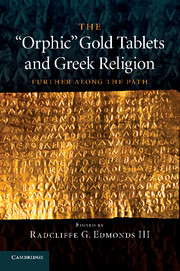Book contents
- Frontmatter
- Contents
- List of contributors
- Acknowledgements
- Note on abberivations
- PART I THE TABLET TEXTS
- PART II TEXTS AND CONTEXTS
- PART III SEMIOTIC AND NARRATIVE ANALYSES
- 8 Funerary gold lamellae and Orphic papyrus commentaries
- 9 Initiation – death – underworld
- 10 Sacred scripture or oracles for the dead?
- 11 Dialogues of immortality from the Iliad to the gold leaves
- 12 Poetry and performance in the Orphic gold leaves
- 13 Rushing into milk
- Compiled Bibliography
- Index
- Index locorum
9 - Initiation – death – underworld
Narrative and ritual in the gold leaves
Published online by Cambridge University Press: 04 February 2011
- Frontmatter
- Contents
- List of contributors
- Acknowledgements
- Note on abberivations
- PART I THE TABLET TEXTS
- PART II TEXTS AND CONTEXTS
- PART III SEMIOTIC AND NARRATIVE ANALYSES
- 8 Funerary gold lamellae and Orphic papyrus commentaries
- 9 Initiation – death – underworld
- 10 Sacred scripture or oracles for the dead?
- 11 Dialogues of immortality from the Iliad to the gold leaves
- 12 Poetry and performance in the Orphic gold leaves
- 13 Rushing into milk
- Compiled Bibliography
- Index
- Index locorum
Summary
I first came across the intriguing pieces made of gold in a seminar run by Walter Burkert in the winter semester 1978/79. Ever since then the scenery evoked on these strange little burial offerings, with all its highly suggestive details, has cast a spell on me: the House of Hades, with two springs off to the right; next to one of them a radiant cypress, over the other (the one fed by the Lake of Memory) guardians posted; moreover the soul, perishing from thirst: its dialogue with the guardians; a sacred path on which μύσται and Βάκχοι are treading (heading wherever they may), and so forth.
The various fragments of pictures and thoughts certainly stimulate our imagination and may induce one to sense a higher concept. However, uninitiated as we are, it is already difficult for us to clear up the puzzling ambiguity of single utterances – let alone to bring together all these elements into a coherent unity, or, as semioticians would put it, to create ‘monosemy’. Moreover, a comprehensive interpretation of these documents is hampered by the fact that even pure philological work in this case rather quickly seems to come to its limits. Already at a first glance, some of the leaves so far published display a closer relationship. This observation led Günther Zuntz, in his fundamental edition and philological exegesis of 1971, to distinguish between groups A and B. (I will leave aside in this place the isolated and quite peculiar C1 leaf, which has provoked different interpretations: while some scholars believe it to contain a magical text, others would look at it as a mystical item, in which the initiated could recognize, in the middle of meaningless characters, names and epithets of gods of the initiation, as well as some mystic formulas.
- Type
- Chapter
- Information
- The 'Orphic' Gold Tablets and Greek ReligionFurther along the Path, pp. 219 - 256Publisher: Cambridge University PressPrint publication year: 2011
- 16
- Cited by

